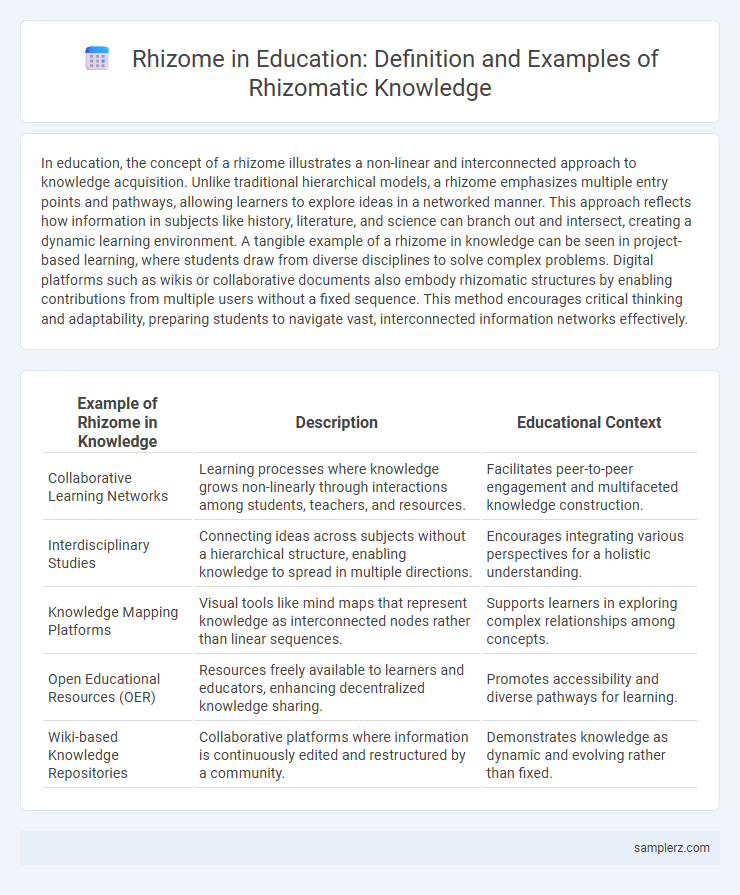In education, the concept of a rhizome illustrates a non-linear and interconnected approach to knowledge acquisition. Unlike traditional hierarchical models, a rhizome emphasizes multiple entry points and pathways, allowing learners to explore ideas in a networked manner. This approach reflects how information in subjects like history, literature, and science can branch out and intersect, creating a dynamic learning environment. A tangible example of a rhizome in knowledge can be seen in project-based learning, where students draw from diverse disciplines to solve complex problems. Digital platforms such as wikis or collaborative documents also embody rhizomatic structures by enabling contributions from multiple users without a fixed sequence. This method encourages critical thinking and adaptability, preparing students to navigate vast, interconnected information networks effectively.
Table of Comparison
| Example of Rhizome in Knowledge | Description | Educational Context |
|---|---|---|
| Collaborative Learning Networks | Learning processes where knowledge grows non-linearly through interactions among students, teachers, and resources. | Facilitates peer-to-peer engagement and multifaceted knowledge construction. |
| Interdisciplinary Studies | Connecting ideas across subjects without a hierarchical structure, enabling knowledge to spread in multiple directions. | Encourages integrating various perspectives for a holistic understanding. |
| Knowledge Mapping Platforms | Visual tools like mind maps that represent knowledge as interconnected nodes rather than linear sequences. | Supports learners in exploring complex relationships among concepts. |
| Open Educational Resources (OER) | Resources freely available to learners and educators, enhancing decentralized knowledge sharing. | Promotes accessibility and diverse pathways for learning. |
| Wiki-based Knowledge Repositories | Collaborative platforms where information is continuously edited and restructured by a community. | Demonstrates knowledge as dynamic and evolving rather than fixed. |
Understanding the Rhizome Concept in Educational Knowledge
The rhizome concept in educational knowledge illustrates a non-linear, interconnected approach to learning, where ideas and information grow horizontally through multiple pathways instead of hierarchical structures. This model encourages collaborative knowledge construction and critical thinking by recognizing diverse perspectives and decentralized connections. Understanding the rhizome framework helps educators design curricula that foster active exploration and adaptation in dynamic learning environments.
Rhizomatic Learning: Transforming Knowledge Structure
Rhizomatic learning exemplifies a non-linear and interactive knowledge structure where ideas spread like interconnected roots, emphasizing collaboration and self-directed understanding. This approach challenges traditional hierarchical models by encouraging learners to navigate concepts dynamically, reflecting the complexity of real-world information networks. By fostering multiple entry points and pathways, rhizomatic learning transforms education into an adaptive, personalized experience that aligns with evolving knowledge ecosystems.
Decentralized Knowledge: Rhizome vs. Traditional Hierarchies
Decentralized knowledge structures mirror the rhizome concept by promoting interconnected, non-hierarchical learning pathways, contrasting sharply with traditional top-down hierarchies in education. This model encourages multiple entry and exit points in knowledge exploration, allowing learners to construct understanding dynamically and collaboratively. Such an approach enhances adaptability and innovation, reflecting the complex, networked nature of information in digital learning environments.
Real-World Examples of Rhizomatic Knowledge Growth
Rhizomatic knowledge growth is evident in open-source software communities like GitHub, where contributors collaboratively develop and modify code without a fixed hierarchy. Wikipedia exemplifies this model by allowing users worldwide to continuously add, edit, and link information, creating a non-linear, ever-expanding web of knowledge. These platforms demonstrate decentralized learning processes that adapt dynamically to new inputs and diverse perspectives.
Collaborative Learning as a Rhizomatic Practice
Collaborative learning exemplifies rhizomatic knowledge by fostering decentralized and non-hierarchical interactions among learners, where ideas spread and evolve through multiple, interconnected pathways. This approach emphasizes collective problem-solving and emergent understanding, mirroring the unpredictable, horizontal growth characteristic of rhizomes. Such dynamic exchanges create a resilient and adaptive knowledge ecosystem, encouraging innovation and critical thinking beyond traditional linear models.
Technology-Driven Rhizomatic Knowledge Networks
Technology-driven rhizomatic knowledge networks exemplify non-hierarchical, interconnected learning structures where information flows multidirectionally across digital platforms like online forums, social media, and collaborative wikis. These networks enable learners to access diverse perspectives and co-create knowledge, reflecting Deleuze and Guattari's concept of rhizomes that emphasize decentralization and multiplicity in knowledge construction. Such systems foster dynamic, adaptive education environments that challenge traditional linear learning models by promoting continuous, networked engagement and innovation.
Adapting Curriculum to Rhizomatic Frameworks
Adapting curriculum to rhizomatic frameworks involves designing learning experiences that reflect the non-linear, interconnected nature of knowledge, encouraging students to explore topics through multiple entry points and pathways. This approach fosters collaborative knowledge construction and critical thinking by allowing learners to navigate and contribute to diverse knowledge nodes rather than following a fixed sequence. Implementing rhizomatic principles supports personalized education, promoting flexibility and adaptability within curricula to meet the evolving needs of learners in dynamic educational environments.
Knowledge Construction through Nonlinear Pathways
Knowledge construction through nonlinear pathways exemplifies the rhizome concept by emphasizing interconnected, non-hierarchical learning networks where ideas branch and loop dynamically. This approach allows learners to navigate multidirectional links, fostering deeper understanding and creative problem-solving. Digital platforms and collaborative projects often serve as practical examples, enabling fluid knowledge expansion beyond traditional linear models.
Empowering Student Agency with Rhizomatic Learning
Rhizomatic learning exemplifies knowledge as a dynamic, non-linear network where students actively navigate and construct understanding based on their interests and experiences. This approach empowers student agency by encouraging exploration, collaboration, and critical thinking outside traditional hierarchical structures. Educators facilitate environments where learning paths continuously evolve, reflecting the rhizome's decentralized and interconnected nature.
Case Studies: Rhizome Principles in Classroom Settings
Case studies in education reveal how rhizome principles create dynamic, non-linear learning environments where knowledge grows through interconnected student interactions rather than hierarchical structures. These settings emphasize collaborative problem-solving and flexible curriculum paths, allowing learners to navigate content based on interests and real-time feedback. Research shows this approach enhances critical thinking and adaptability, fostering deeper engagement and retention in diverse classroom contexts.

example of rhizome in knowledge Infographic
 samplerz.com
samplerz.com